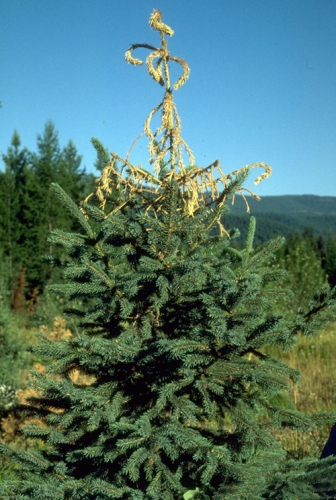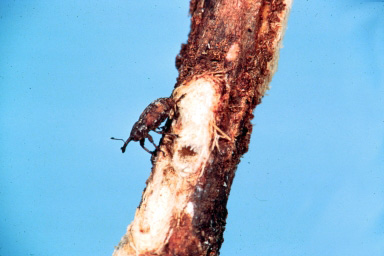White pine weevil damage is being seen now in evergreens
White pine weevils may be the reason why the tops of some evergreens are turning brown.
White pine weevil (Pissodes strobe) is a small insect that can do some big damage. In early spring, the fertilized female weevil moves to the top of the tree in early May and lays eggs on the terminal leader, or tallest part of the tree. Depending where you live in the state, Mom’s appearance could have been anywhere from late April to late May. The larvae soon hatch and bore down under the bark and kill the growing leader at the top of the tree. They also could eventually kill two or three whorls, or horizontal rings, of branches growing at the top of the tree.
By mid-June, many damaged pines and spruces are exhibiting damage. The leader wilts and the new, tender central leader bends over. Later, it becomes a light, dry green and then turns tan. Pines that can be affected are white, red, Austrian and Mugo pines. Scotch pines are not affected. All spruces can sustain damage. Other evergreens like firs, Douglas fir, arborvitaes and others are also exempt.

White pine weevil damage. Photo credit: USA Forest Service, Bugwood.org.
When the leader is examined, there are numerous small holes in the bark and leaking sap or pitch will drip down the leader from the holes. The pitch may be clear and sticky or white and solidified. The pitch has a characteristic evergreen smell.
When bark is peeled off the dying leader, slightly curved, white larvae are found under the bark. If it is later in the summer, those dead leaders can have ragged holes and woody chip cocoons under the bark that look like ovals of tiny wood slivers around the hole. At this point, the larvae are larger or there may also be brown weevil adults that are approximately 1/4 of an inch in length.

White pine weevil adult. Photo credit: USA Forest Service, Bugwood.org.
It is important to inspect all pines and spruces for dying leaders now. Remove those damaged tops immediately and destroy them by burning or burying them. Do not drop them on the ground for the weevils to continue their life cycle at a lower elevation. The reason for the haste in removing dead leaders is that the longer they remain on the tree, the more damage can occur to those whorls below the dead leader.
For this evergreen pest, prevention is the key. By the time the damage is seen, it’s all over except the pruning and crying. The time to spray the leaders on pines and spruces is in mid- to late April, before the females become active. Leaders should be preventatively sprayed with a long-lasting insecticide called cyfluthrin. One well-timed spray will save that year’s upward growth on the tree and possibly up to three of the previous year’s growth.
Timing is everything when dealing with pests. The female weevils move to the top of the trees when the silver maples are producing flowers, so it is important that leaders are sprayed before this happens. Prevention is the key to controlling white pine weevil.
Related Source:



 Print
Print Email
Email




